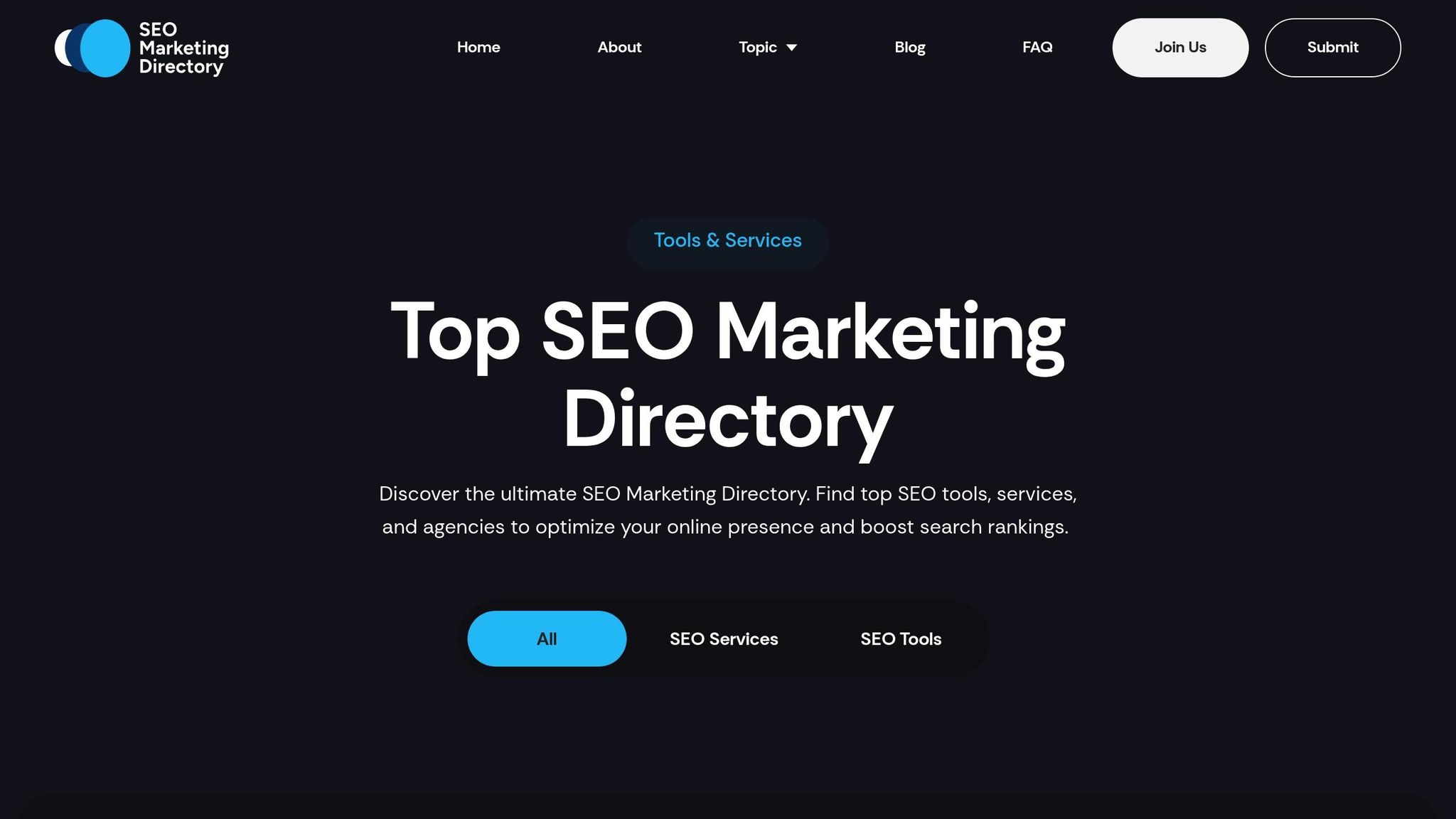Technical SEO automation in 2025 is transforming how websites are optimized. Instead of manually managing every detail, tools powered by AI and machine learning handle audits, detect errors, and improve content performance. These advancements save time, reduce mistakes, and help businesses stay competitive in a constantly evolving online world.
Key Takeaways:
- AI-driven tools now manage audits, content optimization, and performance tracking.
- Real-time monitoring and alerts allow for quick issue resolution.
- Tools like SEMrush, Ahrefs, and JetOctopus cater to businesses of all sizes, from small websites to enterprise-level operations.
- Automation now covers tasks like log file analysis, global position tracking, and even AI-assisted content creation.
Quick Benefits:
- Saves up to 80% of manual audit time.
- Handles large-scale operations (e.g., crawling 500,000+ pages).
- Prioritizes fixes based on impact, ensuring better resource allocation.
Looking for the right tools? Platforms like SEMrush and Ahrefs offer extensive features, while resources like the Top SEO Marketing Directory help businesses compare options based on needs and budgets. Automation isn’t just about keeping up - it’s about staying ahead.
AI Agent for Automatic SEO that Fixes your site's Technical SEO Issues
Tools for Automating Technical SEO
By 2025, technical SEO automation tools have become more advanced, offering everything from basic audits to enterprise-level monitoring solutions. These tools now go beyond simple crawling, using AI to deliver insights, real-time monitoring, and seamless integration with marketing workflows. They reflect key trends like real-time analysis, AI-powered capabilities, and comprehensive automation, making them essential for modern SEO strategies.
Top Technical SEO Automation Tools
SEMrush is a powerhouse platform with over 40 integrated marketing tools, making it ideal for agencies managing multiple clients. Its site audit tool is trusted by thousands of agencies worldwide, and its position tracking spans over 190 countries. SEMrush excels in competitive analysis, offering features like scheduled audits, backlink monitoring, and automated reporting. Plans start at $129.95 per month, with discounts for annual billing. It consistently earns high ratings, often 4.5/5 or above, on major review sites.
Ahrefs is a go-to tool for businesses focused on backlink analysis and competitor research. With one of the largest backlink databases, it offers automated alerts for lost backlinks and technical issues, enabling quick responses to ranking-impacting changes. Known for its user-friendly interface, Ahrefs enjoys ratings around 4.6/5, with pricing starting at approximately $99 per month.
JetOctopus is designed for large-scale audits and boasts one of the fastest crawlers among enterprise tools. It can handle millions of pages and log lines monthly, with entry-level plans including 500,000 crawled pages and 2 million log lines. While its technical depth may not suit beginners, it excels at log file analysis and integrates seamlessly with Google Search Console. Pricing begins at $366 per month when billed quarterly.
Screaming Frog SEO Spider remains a favorite for its precision and flexibility in customizable audits. It offers scheduled crawls, detailed error reporting, and extensive integration options. A free version is available with limited features, while paid licenses start at approximately $259 per year.
Surfer SEO focuses on automating on-page optimization and content planning. It provides data-driven recommendations and AI-generated content briefs, bridging the gap between technical SEO and content strategy. Pricing starts at $89 per month.
For WordPress users, Rank Math Pro simplifies essential SEO tasks like schema markup, internal linking, and instant indexing. Its ease of use and automation features make it popular among WordPress site owners, with plans starting at $59 per year.
| Tool | Best For | Key Automation Features | Starting Price |
|---|---|---|---|
| SEMrush | All-in-one automation | Site audit, backlink monitoring, reporting | $129.95/month |
| Ahrefs | Backlink/competitor analysis | Automated alerts and backlink monitoring | ~$99/month |
| JetOctopus | Large-scale audits | Fast crawling, log analysis, GSC integration | $366/month |
| Screaming Frog | Technical audits | Scheduled crawls, error reporting | $259/year |
| Surfer SEO | Content optimization | AI briefs, SERP analysis, bulk auditing | $89/month |
| Rank Math Pro | WordPress automation | Schema markup, internal linking, indexing | $59/year |
The choice of tool often depends on your business needs and scale. SEMrush and Ahrefs consistently rank among the top three most-used SEO tools in industry surveys as of 2025.
Using the Top SEO Marketing Directory to Find Tools

To simplify the process of finding the right tool, the Top SEO Marketing Directory offers a curated resource for comparing platforms. It highlights solutions that leverage AI and real-time data, aligning with the latest trends. Instead of spending hours researching, the directory allows you to quickly compare tools by features, pricing, and reviews.
The directory includes automation platforms, specialized agencies, and software providers that offer expert guidance for implementation. This is especially helpful for businesses that need assistance selecting the right tools or creating custom automation workflows.
For U.S.-based businesses, the directory is tailored to include pricing in U.S. dollars, local market considerations, and providers familiar with American business practices. It offers three access levels: a free basic plan for tool comparisons, a premium plan at $49 per month for enhanced features, and custom enterprise solutions for larger organizations.
Given that 82% of enterprise SEO specialists plan to increase their investment in AI-powered automation tools in 2025, the directory is a time-saving resource. It helps businesses identify solutions that meet their goals, whether it’s reducing errors, improving crawl efficiency, or enhancing site monitoring.
What sets the Top SEO Marketing Directory apart is its focus on actionable criteria. It evaluates tools based on automation depth, AI capabilities, integration options, scalability, real-time monitoring, and cost-effectiveness. This ensures you can select solutions that deliver measurable returns and address your specific technical SEO challenges effectively.
How to Automate Technical SEO Audits
Automating technical SEO audits effectively requires the right tools, careful setup, and a clear strategy. The process revolves around three main pillars: automated site crawling to detect errors, AI-driven analysis for actionable insights, and scheduling regular audits. Together, these steps simplify maintenance, improve site performance, and reduce manual effort.
Automating Site Crawls and Error Detection
Automated site crawls are the backbone of technical SEO audits. These tools scan your site for common issues like broken links, crawl errors, slow-loading pages, duplicate content, missing metadata, and schema markup problems. The key is to select tools that offer comprehensive site coverage and real-time alerts.
For example, some industry-leading platforms provide unlimited crawling capabilities and immediate notifications for any new or recurring issues. This allows teams to address problems quickly. SE Ranking is a great option for small to medium-sized businesses, offering detailed monitoring and customizable alert thresholds. On the other hand, Screaming Frog SEO Spider is a favorite for teams needing precise control over crawl settings and automated error reporting.
Using AI for Actionable Insights
AI takes technical audits to the next level by turning raw crawl data into clear, prioritized recommendations. These systems analyze patterns, evaluate the impact of issues, and suggest which fixes to prioritize. As websites grow more complex, this capability becomes increasingly important.
AI-powered tools like Conductor and Surfer SEO categorize issues by their potential impact and provide tailored recommendations. Alli AI stands out for its ease of use, particularly for CMS platforms, where it not only identifies optimization opportunities but can also implement some fixes automatically. Advanced AI tools can even estimate the potential traffic or ranking gains from resolving specific problems, helping businesses allocate resources more effectively.
Setting Up Regular SEO Audits
Regular audits are essential for maintaining your site's technical health. Automation tools allow you to customize the frequency of these audits based on factors like your site's size, update frequency, and business needs. For instance, an e-commerce site might require weekly audits, while a smaller corporate site could manage with monthly checks.
When scheduling audits, it’s important to define their scope, determine who will receive the reports, and establish escalation procedures for critical issues. Many platforms allow you to set audit frequencies and create alerts tailored to specific problem types. For example, SEMrush offers tools for tracking trends over time, enabling side-by-side comparisons of past audits to monitor progress and identify recurring issues.
A balanced approach is key. While daily audits might overwhelm you with data, infrequent checks could leave critical problems unnoticed. A common strategy is to schedule comprehensive weekly audits, supplemented by real-time monitoring for urgent issues like site downtime or major crawl errors.
For businesses unsure of which tools to choose, resources like the Top SEO Marketing Directory provide curated comparisons of leading platforms. These guides simplify the decision-making process by highlighting tools that address technical SEO, site audits, and AI-driven optimization. With regular monitoring in place, your website will be better prepared for advanced strategies and challenges down the road.
sbb-itb-5be333f
Best Practices for Technical SEO Automation
To make the most of technical SEO automation, it’s essential to integrate it into your existing workflows, focus on high-priority issues, and ensure ongoing monitoring. Today’s automation tools are designed to streamline processes, reduce manual work, and enhance site performance.
Connecting Automation with Current SEO Tools
A key step in technical SEO automation is linking it with your existing tools. APIs make this possible by allowing data to flow seamlessly between systems, eliminating the need for manual data transfers and creating a unified workflow.
Take Conductor, for example. Its platform connects directly with content management systems and analytics tools via APIs, enabling automated alerts for technical issues. This lets teams access all their SEO data in one centralized location. Similarly, Single Grain integrates automation into comprehensive marketing technology stacks, simplifying tasks like auditing, monitoring, and reporting.
Platforms such as Gumloop and n8n go a step further by enabling custom workflows. These workflows can trigger site crawls, update sitemaps, and send error reports to management systems. Meanwhile, tools like Alli AI and SE Ranking offer built-in automation features that allow even non-technical users to roll out optimizations across multiple CMS platforms without any coding. This ensures that updates are deployed quickly and consistently, even on large websites.
The key to success here is focusing on smooth data exchange and efficient process management. Once you’ve integrated your tools, the next step is tackling the most pressing issues first.
Fixing High-Impact Issues First
Automation shines when it comes to identifying and prioritizing the technical issues that have the biggest impact on your search rankings and user experience. By focusing on these high-impact problems, you can maximize the return on your SEO efforts.
Some of the most critical issues to address include crawl errors, broken links, duplicate content, slow page speeds, and failures in Core Web Vitals. For instance, one e-commerce furniture store saw a staggering 754% boost in organic traffic after implementing AI-driven technical SEO automation that targeted these areas.
Modern automation tools don’t just flag problems - they also evaluate their importance. For example, a broken link on your homepage is far more damaging than one on a little-visited archive page. Automated systems can differentiate between these scenarios, providing a prioritized list of fixes so your team can focus on what matters most.
To manage these issues effectively, set up automated alerts for critical problems and schedule regular audits for less urgent ones. This two-tier approach ensures that business-critical issues are addressed immediately, while ongoing site health is maintained through routine checks.
Once you’ve tackled high-priority problems, the next step is to ensure your fixes are sustainable through continuous monitoring.
Setting Up Continuous Monitoring
Continuous monitoring is the backbone of technical SEO automation. Instead of discovering issues long after they’ve caused damage, real-time systems alert you as soon as problems arise - helping you avoid ranking drops and revenue losses.
A great example of this is ContentKing, which provides 24/7 monitoring and instant change detection. Whether the issue stems from site updates, server errors, or third-party integrations, these alerts allow for quick action - especially crucial during development cycles when updates can unintentionally create SEO problems.
Key metrics to monitor include crawl status, indexability, page speed, Core Web Vitals, mobile usability, structured data errors, and backlink health. Tools like SE Ranking offer automated tracking and immediate notifications for changes in these areas, allowing teams to respond proactively.
For best results, use tools that focus on metrics critical to your business. Set up alert thresholds so major issues, like site downtime, are flagged immediately, while minor problems can be reviewed weekly. The most effective systems combine automation with human oversight, enabling SEO professionals to add strategic insights to the raw data.
Conclusion and Key Takeaways
Technical SEO automation is no longer optional - it’s a must-have for businesses navigating the increasingly intricate digital landscape of 2025. With search engines evolving and websites growing more complex, the advantages of automation are clearer than ever.
Why Technical SEO Automation Matters
Automation can slash manual audit time by up to 80%, making it far easier to identify issues like broken links and duplicate content. Tools like JetOctopus, capable of crawling up to 500,000 pages and analyzing 2 million log lines even on their entry-level plans, showcase the scalability of automation. Similarly, platforms like SEMrush, offering over 40 marketing tools and boasting the world’s largest backlink database, demonstrate how automation helps maintain SEO health across sprawling web properties. These capabilities are indispensable for enterprises managing large-scale websites that would otherwise overwhelm manual processes.
What’s more, automation empowers businesses to adopt a proactive SEO approach. Instead of reacting to ranking drops or revenue losses, real-time monitoring and instant alerts let teams address issues before they escalate. This not only safeguards search performance but also ensures smoother operations and consistent traffic growth.
Finding the Right Tools with the Top SEO Marketing Directory
Choosing the right technical SEO automation tools can feel daunting with so many options available. That’s where the Top SEO Marketing Directory comes in. This curated resource simplifies the process, helping businesses identify tools and services tailored to their needs.
The directory includes detailed listings for leading platforms like SEMrush, Surfer SEO, Ahrefs, Screaming Frog, JetOctopus, and Rank Math Pro. Each listing highlights key features, pricing, and areas of expertise, making it easier for businesses to find solutions that align with their goals and budgets.
Beyond tools, the directory connects businesses with top SEO agencies and service providers specializing in automation. This is particularly useful for companies needing expert help to set up complex workflows or integrate multiple tools into their existing systems. For businesses managing multiple websites or large-scale operations, these resources are invaluable in maintaining competitive search performance.
Building for the Future
In 2025, technical SEO automation isn’t just about staying current - it’s about gaining a competitive edge. By leveraging reliable tools and expert support, businesses can create a scalable, results-driven SEO strategy. Resources like the Top SEO Marketing Directory make it easier to take that first step, ensuring companies are well-equipped to thrive in the ever-changing digital world.
FAQs
How do AI-powered SEO tools decide which technical issues on a website to address first?
AI-powered SEO tools focus on addressing technical issues by evaluating their influence on website performance and search engine rankings. These tools dig into elements like crawlability, indexability, page speed, and mobile usability to pinpoint which problems demand immediate attention.
Using machine learning, many of these tools assess the severity of each issue and its potential impact on both user experience and search visibility. For instance, they might prioritize fixing broken links or resolving server errors over less pressing tasks like tweaking meta descriptions. This approach ensures that the most pressing issues are tackled first, boosting the site's overall performance and search visibility.
What are the main differences between popular technical SEO automation tools like SEMrush and Ahrefs?
SEMrush and Ahrefs are two standout tools in the world of technical SEO, each bringing its own strengths to the table. SEMrush is celebrated for its all-encompassing feature set, offering detailed site audits, keyword tracking, and competitive analysis. It’s a great choice for businesses that want a one-stop shop for managing various aspects of SEO.
On the other hand, Ahrefs shines when it comes to backlink analysis and content research. Its tools are particularly strong for uncovering link-building opportunities and dissecting competitor strategies, making it invaluable for those focusing on these areas.
When deciding between the two, think about your specific needs. If your goal is to manage a wide range of SEO tasks under one platform, SEMrush might be your go-to. However, if your focus is on link-building and digging into competitor insights, Ahrefs could be the better match. Both tools are highly respected and can play a key role in simplifying your technical SEO efforts.
What are the best ways to incorporate technical SEO automation into your workflow for better efficiency?
To bring technical SEO automation into your workflow, the first step is to pinpoint repetitive tasks that can be streamlined. Think about processes like site audits, crawling, and error detection - these are perfect candidates for automation. Using automation tools specifically designed for technical SEO can save you time while ensuring everything runs smoothly and accurately.
Look for tools that include features like automated crawl reports, page speed analysis, and structured data validation. These can help you keep tabs on your website's overall health without needing constant manual checks. The key is to align these automated tasks with your broader SEO strategy, so your campaigns stay both efficient and effective.
If you're unsure where to start, check out resources that highlight expert-recommended tools and strategies for technical SEO. These can guide you toward the latest technologies and best practices to enhance your workflow.


